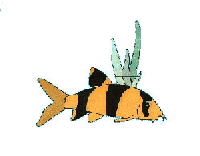ASHTABULA COUNTY AQUARIUM CLUB


ASHCO
BAP Report

Before I begin, I would like
to say that this is the first article that I have written, and is
on spawning the Kribensis, a substrate cichlid, found in Southern Nigeria.
This is the first cichlid that I have attempted to spawn. The Kribensis
prefer slightly brackish water, and a PH around 6.5.
Our attempt to spawn the Kribensis
was relatively easy. We acquired a pair of adult Kribensis at the
end of December 1997. The pair was put together in a 10 gallon
tank. The tank contained an undergravel filter, heater, a piece of
2” pvc pipe and one Java fern plant. It had white gravel, incandescent
lighting and was kept at 82 degrees. The pair did not seem content,
they were continuously hiding in the pvc, they wouldn’t even come
out to eat. They would eat frozen brine shrimp only if
it landed where they could reach it without leaving the pvc.
After reading several articles
obtained from the Internet on other known attempts of spawning this
species, we lowered the tank temp slowly to 78 degrees removed the pvc,
added slate leaning at a 45 degree angle, mixed some dark brown gravel
in with the white added more Java Fern plants and removed one the
light bulbs in attempts to make the tank darker. After ignoring them
for two days we began feeding again with frozen brine shrimp. They
came right out to eat and continued eating 3 times a day; we found
that this pair would not eat flake, blood worms, or cichlid pellets.
Within one week of all these changes they spawned (December 30).
The eggs were hanging on the
underside of the slate and were off white in color. From a couple
of quick glances there looked to be approximately 30 eggs. Two days
later they were gone. The parents had eaten them, but after talking
to Bob & Val Swanson they explained that the eggs where probably no
good since the color was bad, they explained that the female hadn’t laid
eggs in a while so it might take a couple of times to get good eggs.
Eggs should be amber in color.
We gave them back their pvc,
changed nothing else. Continued doing weekly 10% water changes with a light
salinity 3/4 tablespoon for the tank. February 14th Happy Valentines
Day! Upon our return from our monthly ASHCO Aquarium club meeting,
Eggs! This time they laid eggs inside the pvc - looked to be about
30 again. We considered pulling the eggs this time but everyone says
that the Kribs are good parents and take care of their young very well
with no help. February 17 we had wigglers, but very few left, only
about a dozen. We tried not to be too nosy thinking that this may
be the reason that they were snacking. February 20th, no sign of
any fry, they most of finished them off. The pair seemed to be off
in a corner of the tank instead of near the pvc. February 23rd some
friends were over, they noticed fry swimming under the parents about 6
of them. We started feeding frozen baby brine in addition to the
adult brine. February 25th we got a better count; seven.
March 6th we moved the babies to a separate tank to attempt to spawn the
pair again, hoping to get more fry this time.
March 11th the pair laid approximately
40 eggs in the pvc, this time we are attempting to hatch the eggs ourselves
in a separate tank without the parents help. In a 10 gallon tank
with an air stone flowing over eggs lightly. Tank temp 80 degrees,
low salinity.
March 14th, we have failed!
The eggs fungused. We have also noticed that the male looks to have
pop-eye. April 1st the male has died. I guess that we will
have to try again if we are lucky enough to end up with a pair out
of these 7 fry - which by the way were ugly but are now starting to resemble
an adult Kribensis’s color patterns. Sexing the Kribs can be
tricky - rounded pink belly indicates female, pointy dorsal
fin indicates male.
by: Elsie M. Swanson
HOME
This page hosted by ![]()
Get your own Free Home Page